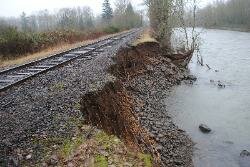| Last Update: Feb 20, 2012 |
| History of the OPR - East Portland Branch - Molalla Branch - Videos of the OPR in Action News & Upcoming Events - Photos of Past Events - Roster of the OPR Special Features |
| History of the OPR - East Portland Branch - Molalla Branch - Videos of the OPR in Action News & Upcoming Events - Photos of Past Events - Roster of the OPR Special Features |
| Copyright © 2004-2012 All Rights Reserved |
| In early February, heavy rains combined with snow melt caused record flooding conditions in Northwest Oregon. While not the largest floods ever seen such as those that occurred in 1996 and 2008, the flood waters were significant enough to cause some damage and risk of damage on the OPR. On the Molalla Branch, the Molalla River reached flood stage and began to errode a section of grade that ran along the tracks near the Molalla River bridge. The erosion was discovered by the crew as they attempted to run a from the south end of the branch to the interchange. The train was stopped prior to crossing over the washout and the line was shut down until emergency repairs could be made. The OPR has limited crew and resources, so all projects and work was stopped and every effort was made to restore the line to operation within a few days. Heavy equipment had to be rented and rock and material had to be immediately sourced and delivered to the site. The line was only out of service for several days due to the hard work of the crew. Fortunately, track damage was minimal but if not for the experience of the crew which are cross trained and experienced in heavy equipment operation and track repair, it would have likely taken much longer and been more expensive. All photos taken by OPR Manager of Train Operations, Craig Samuels. |
| Fixing a Washout on the Molalla Branch |

| These photos show the initial damage on the grade by the flood waters of the Molalla River. Track damage was minimal, but the grade was no longer safe to allow trains to pass through. Heavy rock was delivered to RSG Forest Products at the south end of the branch and loaded onto the OPR's only dump car, which was luckily stored at RSG. |
| Day 1 |
| Day 2 |
| On the first day, the crew dumped as much heavy material as they could into the holes. This included huge rock that had to be purchased and other concrete waste material. |
| On the second day, the crew finished filling in the holes and then laid concrete barriers down to form a wall to help secure the track. A top layer of gravel was laid on the track and over the washout area. All fixed and ready to go! That's how it's done. |




































































